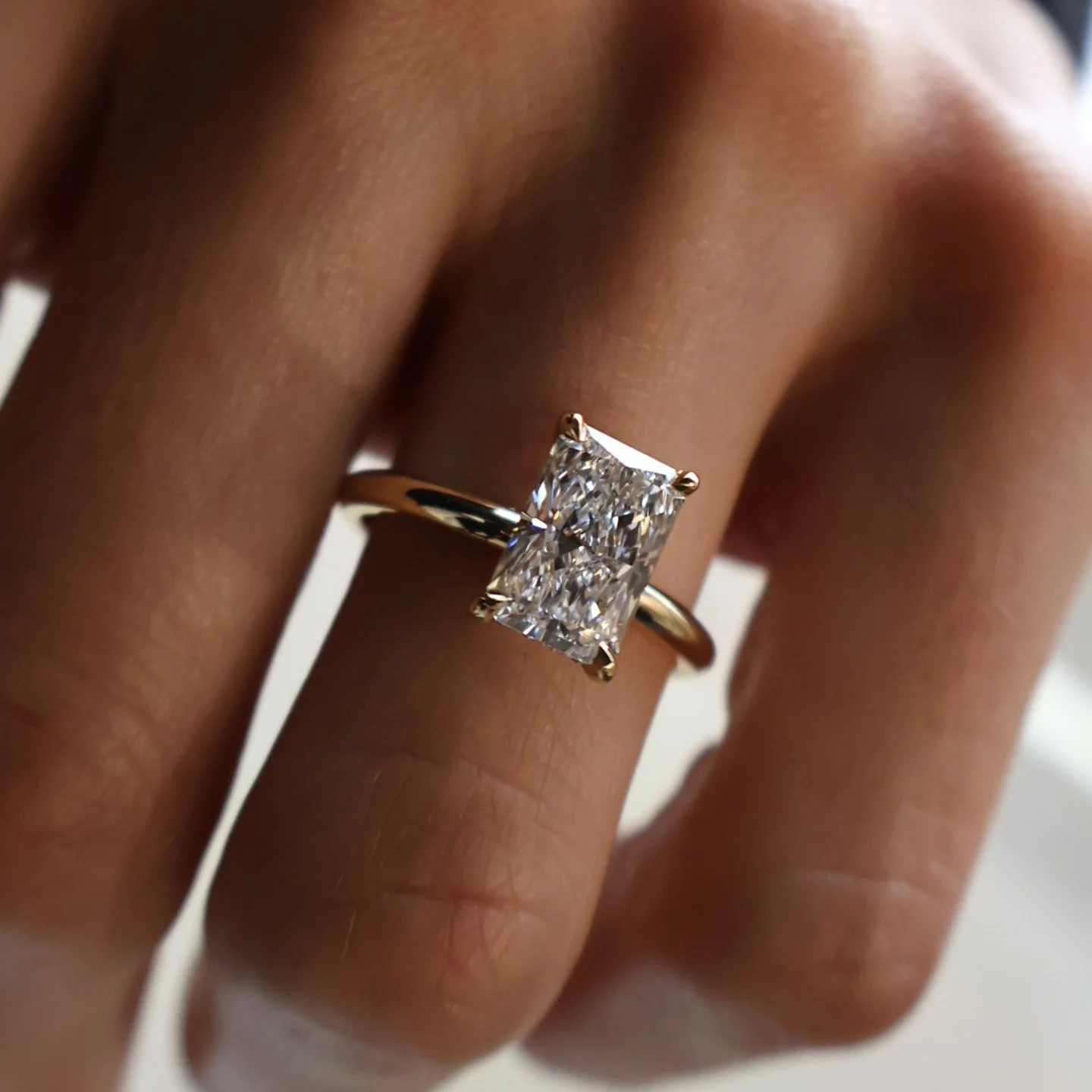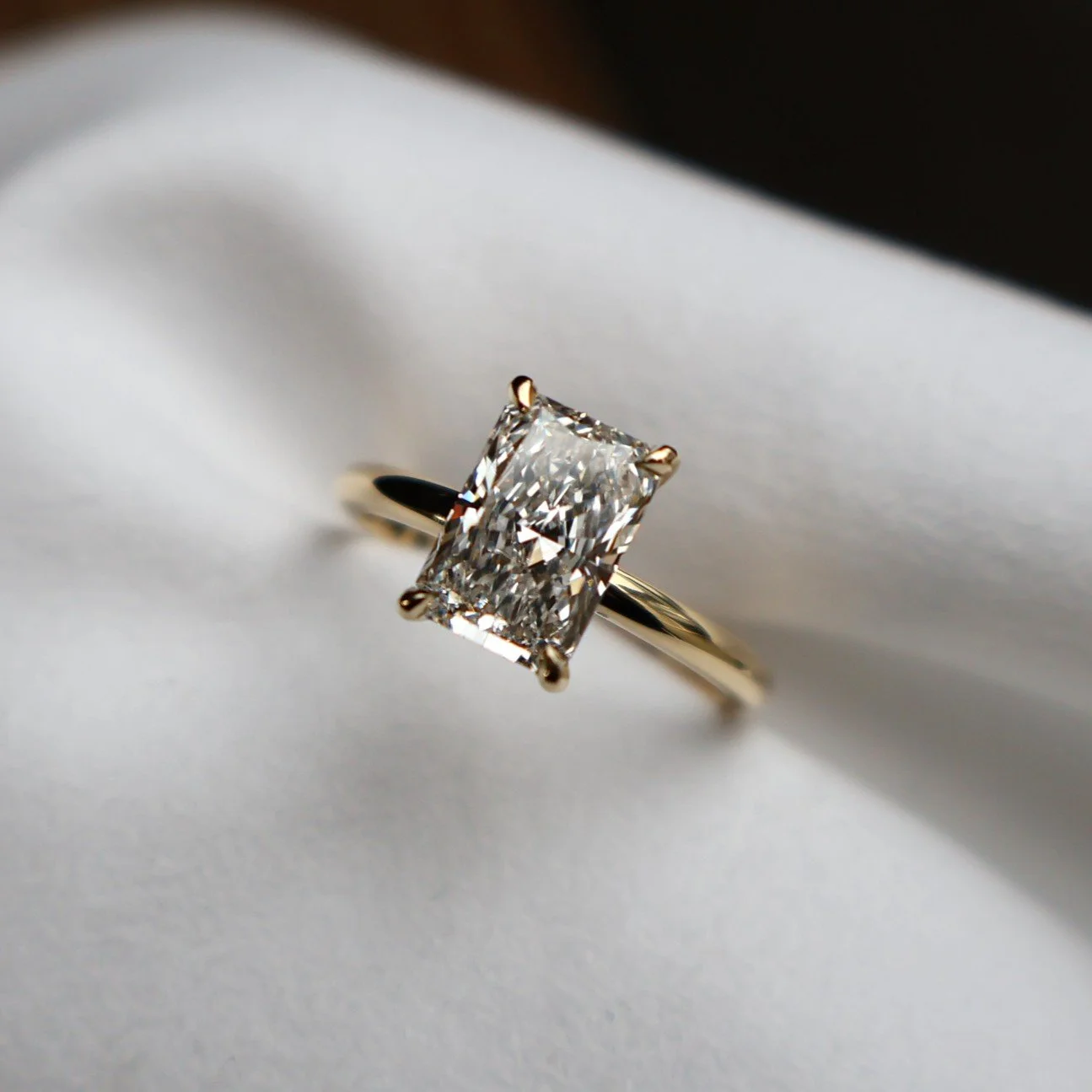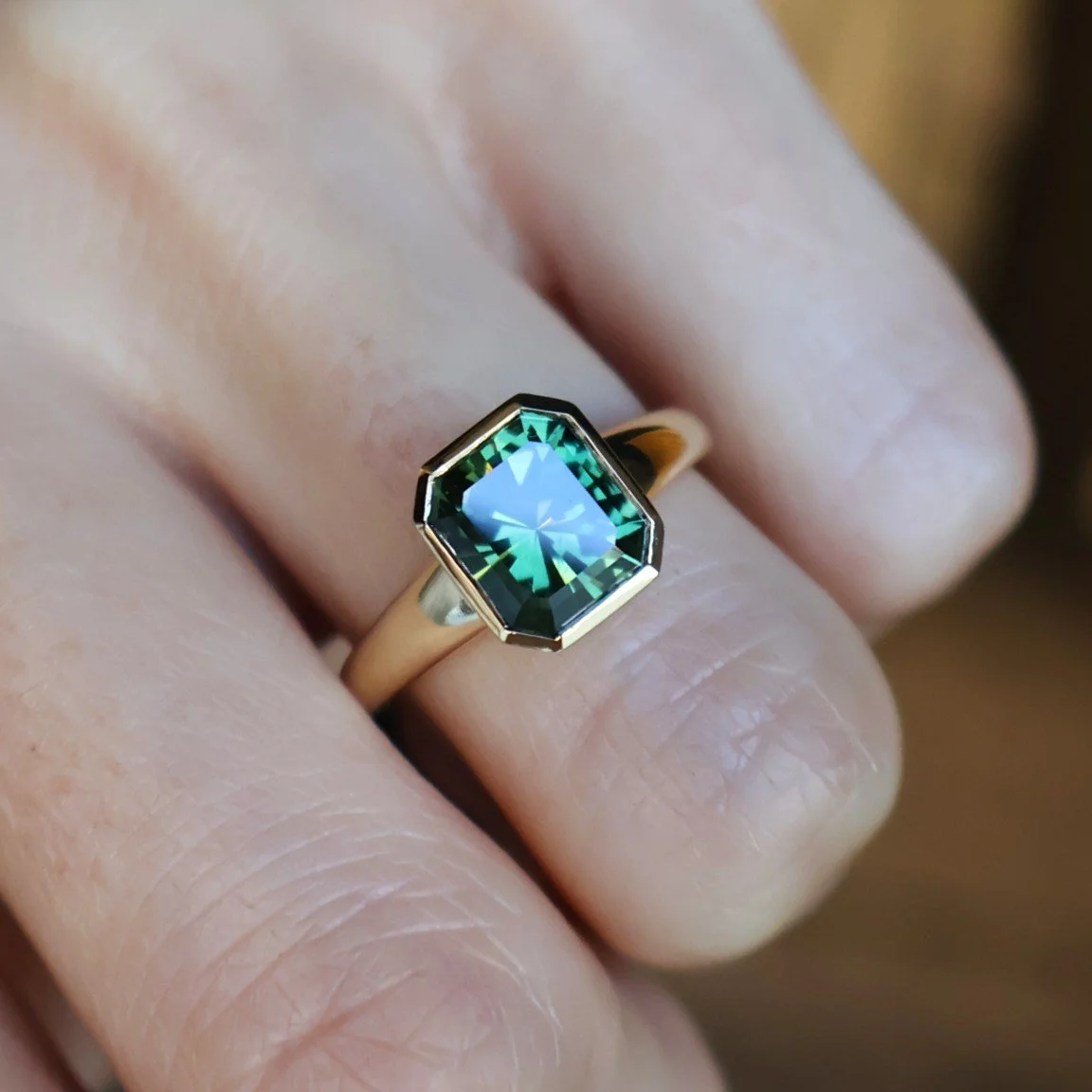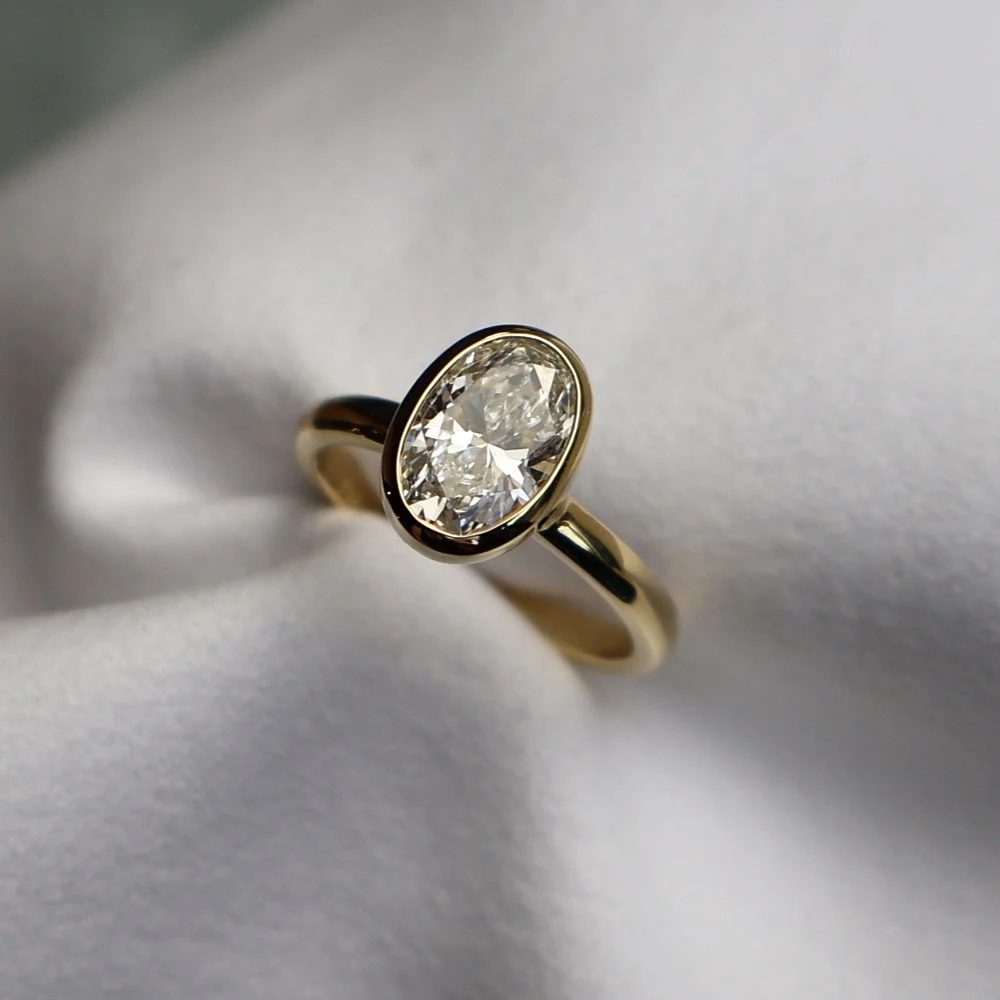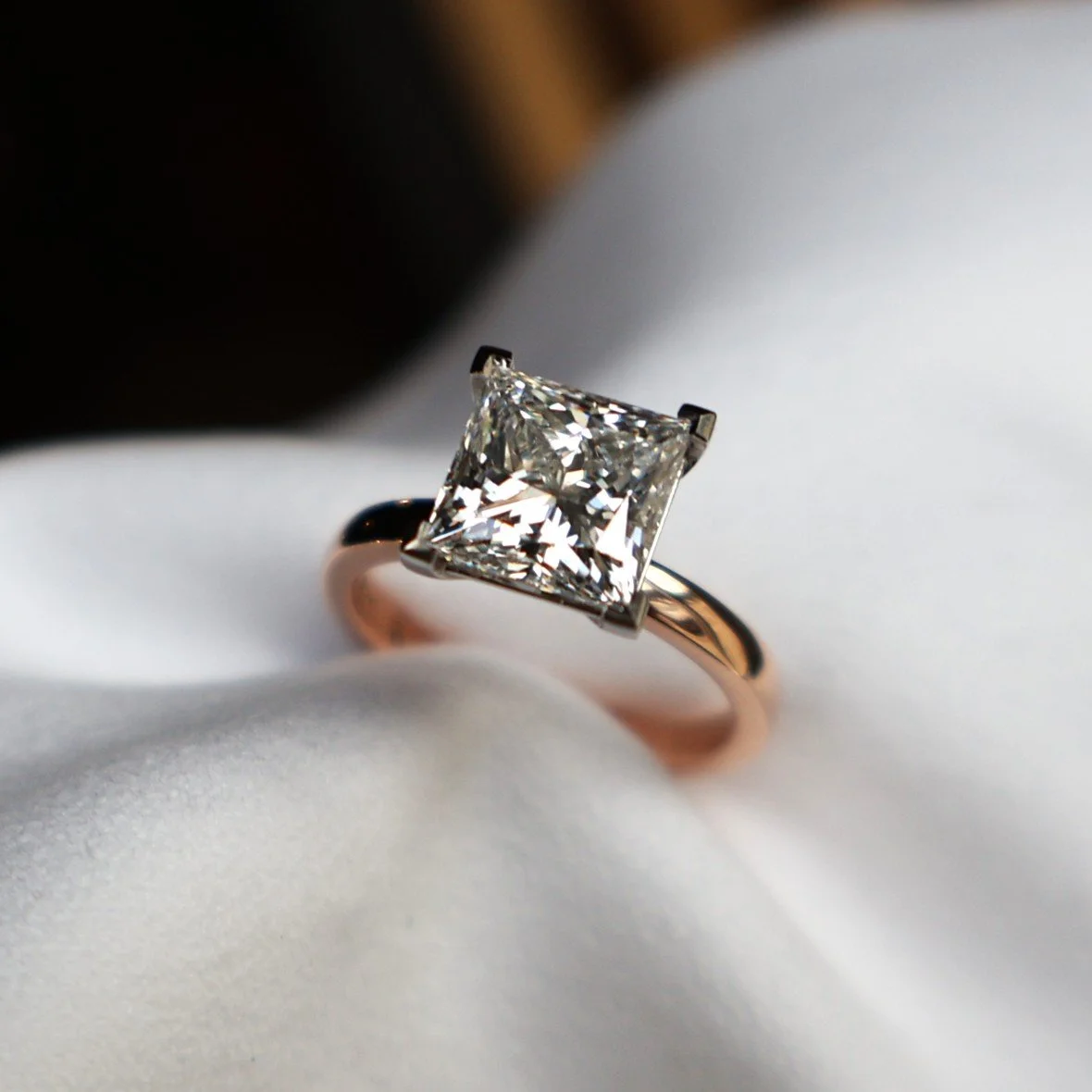Solitaire Engagement Rings | 4 Key Aspects to Consider
In our latest blog article, I’ll be writing about the subtle art of designing a solitaire engagement ring. My aim is to guide you through the essential design aspects that shape the style and wearability of these rings.
Drawing from over a decade of experience as a goldsmith, jewellery designer and gemmologist, I'm passionate about the craftsmanship and design behind each piece.
By exploring the elements that define a solitaire ring – from the choice of center stone and setting style to the ring profile and metal selection – you'll gain valuable insights into creating a ring that resonates with your style while keeping classic elements.
18ct yellow gold elongated radiant-cut diamond solitaire ring
What is covered in this blog article | Solitaire ring design aspects
Choosing your center stone (most important)
Claws and prong style
Band profile and width
Metal options | 18ct yellow, rose gold, white gold, platinum
Solitaire ring FAQ’s
When choosing the center stone for your solitaire engagement ring, there are three key factors to consider: 1- Variety (colour), 2- Shape, and 3- Size.
Your center stone is the focal point of the ring, which is why it plays such a crucial role in determining the overall look and feel of the design.
For engagement rings, diamonds and sapphires are the most popular choices. If you're considering a diamond, the classic options are white, yellow, or champagne diamonds. For a more unique touch, there are rare options like blue and pink diamonds, though these can come with a higher price tag.
I've written articles that provide more insight into both diamonds and sapphires, the links are included below for further reading.
Diamond options | Natural or Lab:
When choosing between natural and lab-grown diamonds, the primary difference lies in how they were created.
Lab-grown diamonds are created in a lab, while natural diamonds are formed over billions of years deep within the Earth.
Both options are available in colors like white, yellow, champagne, or even pink, and each has its own appeal depending on your preferences.
Article | Difference Between Lab and Natural Diamond
Sapphire varieties | A rainbow of colour options:
As for sapphires, they offer a wide range of colors, from blue and green to pink, purple, yellow, and even peach.
The origin dictates what colours might be available, for instance, green and teal sapphires are commonly found in Australia while lighter blue sapphires are often sourced from Sri Lanka and Madagascar.
Origin might might be more important to you than the colour, as it might be a place where you and you significant other met.
Article| How to choose a sapphire | Tip’s from a Gemmologist
Choosing the shape of your solitaire center stone
The shape of your solitaire center stone sets the tone for the style of an engagement ring. The shape can enhance the stone’s size, sparkle, brightness and colour distribution.
When selecting the shape of your solitaire center stone, there are three main aspects to consider:
Length: Whether the gemstone is elongated (long and narrow) or tabular (short and wide).
External Edges: Whether the edges are rounded or square.
The sparkle: How bright the gemstone looks which is governed by the cut (The shape of each facet)
Gemstone shapes from top left: Round-shape, Emerald-Cut, Oval, Cushion-Cut, Marquise, Pear
Elongated Shapes | These include emerald-cut, oval, pear, elongated cushion-cut, marquise, and radiant-cut.
Tabular Shapes | Round, square-cushion, Asscher-cut, and princess-cut (square).
Rounded Shapes | Round, oval, pear, and marquise stones fall into this category.
Square Shapes | These include emerald-cut, Asscher, radiant-cut, and princess-cut stones.
The outlier is a cushion cut which is both square and rounded.
If a client is looking for a sparkly gemstone, I advise them to look at brilliant-cuts stones. Brilliant cut gemstones have triangular and kite shaped facets which reflect the light as more of a sparkle.
On the other hand, step cut gemstones have rectangular facets. Step-cut gemstones give a more structured look to the ring.
The shape of your chosen gemstone should suit your style, if you are looking for straight clean lines, an emerald-cut or Asscher cut might work well. If you are looking for pop and sparkle, a round brilliant-cut, oval or radiant-cut would be a good place to start.
Solitaire radiant-cut lab diamond 2cts set in pointed claws
Designing the mount | Consider setting style and placement
When designing your solitaire engagement ring, the style of the setting plays a significant role in both the functionality and style of the ring.
The setting, also known as claws, prongs or ‘the mount’ are responsible for holding the gemstone securely in place. It's important to consider both their size and design. Additionally, the shape and colour of your chosen sapphire or diamond should guide your decision on which setting finish will best complement the stone.
Below is a list of various claw styles to choose from, each providing a different look for your ring:
Pointed Claws
Pointed claws offer a fine, delicate appearance, drawing attention to the gemstone while keeping it subtly secured.
Rounded Claws
Rounded claws give a classic, soft finish. This is a timeless option that complements most rounded gemstone shapes.
Double claws
Double claws are often seen in vintage or antique-style rings, adding extra detail and a distinctive look. If you're after a ring with an old-world charm, consider adding double claws to your design.
V claws
V claws are ideal for gemstones with pointed corners, such as princess-cuts, pear-shaped, and marquise-shaped stones. This style provides a unique, secure setting for these shapes.
Bezel Setting
Bezel set rings are sleek and modern, providing a clean, contemporary finish. They also offer excellent security, making them great for larger gemstones.
Semi Bezel Settings
Semi bezel settings offer similar security as a full bezel but with less coverage over the stone. This allows for a beautiful balance between protection, framing and showcasing the gemstone.
The ring surface | Band profile and width
The profile of the band creates either a softer overall look or a sharper more defined look.
Fully rounded and half-round bands create a softer, more subtle finish for the ring. These rounded profiles often give the impression of a finer, more elegant piece, especially compared to flat bands.
If you're aiming for an antique, classic, or gentle look, a half-round band is a great option.
On the other hand, flat bands have a sleek, contemporary feel. They tend to pair well with square-edged gemstones, like emerald-cut and Asscher-cuts. Flat bands give the ring a more substantial, modern look.
When our clients are deciding on which band profile to go with, I get them to try on both flat band and rounded band rings so they can see how each profile look on their hand and with their center stone.
How thick or wide should an engagement ring be?
We strongly recommend a band width of at least 1.8mm, ideally 2mm for strength and durability reasons.
For reference, the first photo in the blog is a solitaire diamond ring made with a band that is 2mm thick.
The solitaire green sapphire ring shown above features a band width of 4.5mm, tapering down to 2.5mm at the back.
Wider bands tend to provide a more modern, bold appearance, while narrower bands can offer a more delicate and refined feel.
Oval solitaire diamond ring with a 2.2mm wide half-round band
Metal options | 18ct yellow, rose gold, white gold or platinum
All engagement rings made at Set Together Jewellery are made with either platinum or gold no less than 18ct in purity.
This is because lower percentage gold, for example 14ct or 9ct may tarnish and dis-colour over time which is why 18ct gold is the best to use.
18ct gold is 75% pure gold, the added 25% is a mixture of silver, copper and other metals.
These added metals make the gold stronger and workable, as pure gold is too soft.
What colour of gold should I choose for an engagement ring?
18ct gold is available in yellow, rose and white. Generally choosing the same colour metal as the jewellery you or your partner already wear is a good start.
Otherwise matching the colour to your skin tone is ideal.
Yellow gold is the most classic type of metal to use in a solitaire engagement ring.
You can also make the setting in white gold or platinum to enhance the brightness of the center stone, this gives an elegant look to an engagement ring.
Solitaire diamond engagement ring made in platinum and 18ct rose gold featuring a princess-cut diamond with V claws.
Solitaire Engagement Ring FAQ’s
-
A solitaire engagement ring is the most classic style, so yes, it is a good style for an engagement ring.
The quality of a solitaire engagement ring depends on the quality of the craftsmanship and the quality of the center stone.
-
For $5000AUD you can expect to get up to a 0.50ct diamond made into an 18ct yellow gold ring.
-
For $5000AUD you can get a solitaire 2ct+ lab diamond engagement ring made in platinum or 18ct gold.
-
A 1ct diamond is equal to 0.20grams.
Carat is a form of weight measurement used when weighing diamonds and gemstones.
A round 1ct diamond should measure 6.4mm in diameter.
About the author: Lisa Clune is a qualified Jewellery Designer, Goldsmith, and Gemmologist. To learn more about her work and journey, visit her profile or read her latest interview.
Are you looking for a solitaire engagement ring? We are located on the Sunshine Coast, QLD, we also work remotely with interstate and international clientele. More info on our remote jewellery design service
For other enquiries, Contact us here


